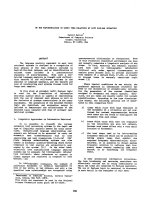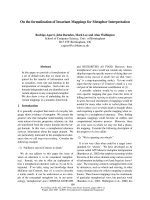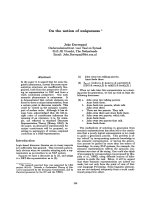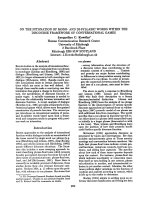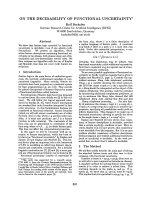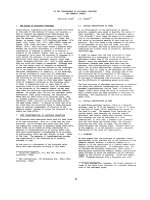Báo cáo " Some problem on the shadow of segments infinite boolean rings " doc
Bạn đang xem bản rút gọn của tài liệu. Xem và tải ngay bản đầy đủ của tài liệu tại đây (127.92 KB, 4 trang )
VNU Journal of Science, Mathematics - Physics 23 (2007) 221-224
Some problem on the shadow of segments infinite boolean
rings
Tran Huyen, Le Cao Tu
∗
Department of Mathematics and Computer Sci ences University of Pedagogy, Hochiminh city
745/2A Lac Long Quan, ward 10, Dist Tan Binh, Hochiminh city, Vietnam
Received 18 September 2007; received in revised form 8 October 2007
Abstract. In this paper , we consider finite Boolean rings in which were defined two orders:
natural order and antilexicographic order. The main result is concerned to the notion of shadow
of a segment. We shall prove some necessary and sufficient conditions for the shadow of a
segment to be a segment.
1. Introduction
Consider a finite Boolean ring: B(n) = {x = x
1
x
2
x
n
: x
i
∈ {0, 1}} with natural order ≤
N
defined by x ≤
N
y ⇔ xy = x. For each element x ∈ B(n), weight of x is defined to be: w(x) =
x
1
+ x
2
+ + x
n
i.e the number of members x
i
= 0.In the ring B(n), let B(n,k) be the subset of all
the elements x∈ B(n) such that w(x)= k.
We define a linear order ≤
L
on B(n,k) by following relation. For each pair of elements x, y ∈
B(n,k), where x = x
1
x
n
, y = y
1
y
n
, x ≤
L
y if and only if there exists an index t such that x
t
< y
t
and x
i
= y
i
whenever i > t. That linear order is also called antilexicographical order. Note that each
element x = x
1
x
n
∈ B(n,k) can be represented by sequence of all indices n
1
< < n
k
such that
x
n
i
= 1. Thus we can identify the element x with its corresponding sequence and write x =(n
1
, n
k
).
Using this identification, we have: x = (n
1
, , n
k
) ≤
L
(m
1
, , m
k
) = y whenever there is an index
t such that n
t
< m
t
and n
i
= m
i
if i > t.
It has been shown by Kruskal (1963), see [1], [2] that the place of element x=( n
1
, n
k
) ∈B(n,k)
in the antilexicographic ordering is:
ϕ(x) = 1 +
n
1
− 1
1
+ +
n
k
− 1
k
1
(Note that
n
r
is a binomial coefficient (n-choose-r) and
m
t
= 0 whenever m < t) .
We remark that ϕ is the one-one correspondence.Therefore ϕ(A) = ϕ(B) is equivalent to A = B, for
every subsets A, B in B(n,k).
Now, suppose a∈ B(n,k) with k > 1, the shadow of element a is defined to be ∆a = {x ∈
B(n, k − 1) : x ≤
N
a}. If A ⊂ B(n,k), the shadow of A is the union of all ∆a, a ∈A i.e ∆A =
∗
Corresponding author. E-mail:
221
222 Tran Huyen, Le Cao Tu / VNU Journal of Science, Mathematics - Physics 23 (2007) 221-224
a∈A
∆a = {x ∈ B(n, k−1) : x ≤
N
a for some a ∈ A}.Thus the shadow of A contain all the elements
x ∈B(n,k-1) which can be obtained by removing an index from the element in A.The conception about
the shadow of a set was used efficiently by many mathematicians as: Sperner, Kruskal, Katona,
Clement, ?
We shall study here the shadow of segments in B(n,k) and make some conditions for that the
shadow of a segment is a segment. As in any linearly ordered set, for every pair of elements a,b
∈ B(n,k), the segment [a,b] is defined to be: [a,b]={x ∈ B(n, k) : a ≤
L
x ≤
L
b}. However, if
a=(1,2, ?,k)∈ B(n,k) is the first element in the antilexicographic ordering, the segment [a,b] is called
an initial segment and denoted by IS(b) so IS(b)={x ∈ B(n, k) : x ≤
L
b}. We remind here a very
useful result, proof of which had been given by Kruskal earlier (1963), see [4], [2]. We state this as
a lemma
Lemma 1.1. Given b = (m
1
, m
2
, , m
k
)∈B(n,k) with k > 1 then ∆IS(b) = IS(b
′
), where b
′
=
(m
2
, , m
k
) ∈ B( n, k − 1) ?
This result is a special case of more general results and our aim in the next section will state
and prove those. Let a =(n
1
, n
2
, , n
k
) and b =(m
1
, m
2
, , m
k
) be elements in B(n,k). Comparing
two indices n
k
and m
k
, it is possible to arise three following cases:
(a) m
k
= n
k
= M
(b) m
k
= n
k
+ 1 = M + 1
(c) m
k
> n
k
+ 1
In each case ,we shall study necessary and sufficient conditions for the shadow of a segment to
be a segment.
2. Main result
Before stating the main result of this section, we need some following technical lemmas. First
of all, we establish a following lemma as an application of the formula (1):
Lemma 2.1. Let a =(n
1
, n
2
, , n
k
) and b =(m
1
, m
2
, , m
k
) be elements in B(n,k) such that
n
k
≤ m
k
< n. and let M be a number su ch that m
k
< M ≤ n. Define x =(n
1
, n
2
, , n
k
, M),
y=(m
1
, m
2
, , m
k
, M) ∈B(n,k+1). Then we have:[x,y]={c +M : c ∈ [ a,b]} and [a,b]={ z -M : z ∈
[x,y]}.
(Note that here we denote x = a+M and a = x-M )
Proof. It follows from the formula (1) that, for any c∈ [a,b],
ϕ(c+M ) = ϕ(c)+
M − 1
k + 1
, therefore ϕ({c+M : c ∈ [a, b]}) = [ϕ(a)+
M − 1
k + 1
; ϕ(b)+
M − 1
k + 1
]= [ϕ(x); ϕ(y)] = ϕ([x; y]) So [x; y]= {c + M : c [a,b]}. By using similar argument for
the remaining equality, we finish the prove of the lemma.
As an immediate consequence,we get the following
muc Lemma 2.2. Let a,b ∈ B(n,k) be elements such that a =(1, ,k-1, M) and b =(M-k+1, ,M-1,M)
then the shadow ∆[a, b] = IS(c) with c =(M-k+2, ,M-1,M )∈ B(n,k-1).
Proof Choose g =(1, ,k-1); d=(M-k+1, ,M-1) in B(n,k-1).Then it follows from lemma 2.1 that A
={x-M : x ∈[a,b]}= [g; d]=IS(d). However, we also have from the lemma 1.1 that ∆A = ∆IS(d) =
IS(c − M) . Repeating to apply the lemma 2.1 to the set B ={z + M : z ∈ ∆A}. We have obtained
Tran Huyen, Le Cao Tu / VNU Journal of Science, Mathematics - Physics 23 (2007) 22 1-224 223
B=[h;c] where h=(1, ?,k-2, M). Note that ϕ(d) +1 = ϕ(h) so A and B are two consecutive segments.
Therefore their union: ∆ [a; b] = A ∪ B = IS(d) ∪ [h; c] = IS(c) is an initial segment. The proof is
completed. We now get some useful consequences of this lemma as follows:
Corollary 2.1. Let a=(n
1
, , n
k−1
, M) and b=(M − k + 2, , M, M + 1) be elements in B(n,k) then
∆[a, b] =IS(c) with c =(M − k + 3, , M, M + 1)∈ B(n,k-1).
Proof. Choose d=(1, ?,k-1, M+1)∈ B(n,k) then [d; b] ⊂ [a;b].By the lemma 2.2, we have ∆[d, b]
=IS(c) with c =(M-k+3, ?, M, M+1)∈ B(n,k-1). However, we also have: [a,b]⊂IS(b) so ∆[a, b]⊂
∆IS(b) = IS( c). Thus ∆[a, b]⊂ ∆(b) =IS(c) as required.
Corollary 2.2. Let a =(1, ?,k-1,M ); b =(m
1
, , m
k−1
, M + 1) be elements in B(n,k) then ∆[a, b]
=IS(c) where c =(m
2
, , m
k−1
, M + 1)∈ B(n,k-1).
Proof. In the proof of this result, we denote: h =( M-k+1, ?,M )∈ B(n,k), d =(M-k+2, ?,M ),
g =(1, ?,k-2, M+1), c =(m
2
, , m
k−1
, M + 1) in B(n,k-1). Then ,again by the lemma 2.2, we
have: ∆[a, h] = IS(d)⊂ ∆[a, b]. Obviously, we also have [g;c]⊂ ∆[a, b]. Therefore, ∆[a; b] ⊃
(IS(d) ∪ [g; c]) = IS(c) and as in above proof it follows that∆[a, b] =IS(c).
Corollary 2.3.Let a =(n
1
, n
2
, , n
k
) and b =(m
1
, m
2
, , m
k
) ∈ B(n,k) be given such that m
k
> n
k
+1
then ∆[a, b] =IS(c) where c =(m
2
, , m
k
) ∈ B(n,k-1).
Proof. Since m
k
> n
k
+ 1, there must be a number M such that n
k
+ 1 ≤ m
k
− 1 = M. Choose
d=(1, ?,k-1, M )∈ B(n,k), we therefore have [d;b]⊂ [a;b]. Note that the segment [d;b] satisfys
conditions of corollary 2.2, we now imitate the above proof to finish the corollary. Certaintly, the last
corollary is a solution for our key questions, in the case (b). What about the remaining case ? First of
all, we turn our attention to the case (a) and have that:
Theorem 2.1. Let a,b ∈ B(n,k) be elements such that a =(n
1
, , n
k−1
, M) and b =(m
1
, , m
k−1
, M)
then ∆[a, b] is a s egment if and only if m
1
= M − k + 1and either n
k−1
< M −1 or n
k−2
= k − 2
Proof. Take c =a -M; d=b - M ∈B(n,k-1) then ∆[a; b] = [c; d] ∪ {x + M : x ∈ ∆[c, d]}. Suppose that
∆[a, b] is a segment then there must have g =(1, ?,k-1)∈∆[c; d] and ϕ(d) + 1 = ϕ(g +M). Therefore
we have that d =(M-k+1, ?,M-1) i.e m
1
= M − k + 1. In the case n
k−1
= M − 1 , since g+M ∈
∆[a, b] so h=(1, ?,k-2, M-1, M )∈[a,b]. Therefore, a ≤ h. However, n
k−1
= M − 1 follows that
h = (1, ?, k−2, M−1, M) ≤ (n
1
, , n
k−2
, M−1, M) = a. Thus a =h , i.e, n
k−2
= k−2. Conversely,
suppose that a =(1, ?,k-2,M-1, M ) and b =( M-k+1, ?, M-1, M). We shall prove that ∆[a, b] is a
segment. Apply the lemma 2.2 to segment [a-M; b-M], we obtain ∆[a − M, b − M ] = IS(c) where c
=( M-k+2, ?, M-1). We now have ∆[a; b] = [a −M; b−M]∪ {x+M : x ∈ IS(c)} to be the union of
two consecutive segments. Therefore,it is a segment. In the case n
k−1
< M − 1, apply the corollary
2.1 ( if n
k−1
= M −2) or the corollary 2.3 (if n
k−1
< M −2 ) to the segment [a-M; b-M] we obtain
∆[a−M, b−M ] = IS(c) for some c ∈ B(n, k-2). Thus ∆[a; b] = [a−M ; b−M] ∪{x+M : x ∈ IS(c)}
as above is the union of two consecutive segments, therefore is a segment.
Finally, we return attention to the case (b)with m
k
= n
k
+ 1. There are two ablities for index
m
1
: m
1
= M − k + 2 and m
1
< M − k + 2 . The former is easily answered by the corollary 2.1 so
here we only give the proof for the latter.In fact, We define the number s as follows
s = min{t : m
k−t
≤ M − t} 2
We close this section with the following theorem:
224 Tran Huyen, Le Cao Tu / VNU Journal of Science, Mathematics - Physics 23 (2007) 221-224
Theorem 2.2. If a =(n
1
, , n
k−1
, M) and b =(m
1
, , m
k−1
, M + 1) ∈ B(n,k) satisfying m
1
≤ M −
k + 1 . then we have that:
(a) In th e case n
k−s+1
< M − s + 1, ∆[a, b] is a segment.
(b) In the case n
k−s+1
= M − s + 1, ∆[a, b] is a segment if and only if ϕ(a
′
) ≤ ϕ(b
′
) + 1
and either n
k−s
< M − s or n
k−s−1
= k − s − 1 where a ’=(n
1
, , n
k−s
) and b’=(m
1
, , m
k−s
) ∈
B(n,k-s).
Proof. Choose h =(M-k+1, , M-1); c =a-M; d = b-(M+1)∈ B(n, k-1) and define set X={y + (M +
1) : y∈ ∆IS(d)}. Since [a;b]= [a; h+M]∪{x + (M + 1) : x ∈ IS(d)}. We have ∆[a; b] =
IS(d) ∪ ∆[a; h + M] ∪ X. Note that two members IS(d) and X of this union are segments and
ϕ(max ∆[a, h+M ])+1 = ϕ(min X) so ∆[a, b] is a segment if and only if the union IS(d) ∪∆[a; h+M ]
is a segment. In the case that n
k−s+1
< M − s + 1, there must be g=(1, ,k-s, M-s+1, ,M )∈ B(n,k)
such that g ∈[a; h+M]. Denote g’=(1, ?,k-s, M-s+1) and h’=(M-k+1, ,M-s,M-s+1) ∈B(n, k-s+1). By
lemma 2.2, we obtain an initial segment. Therefore the set Y defined by Y={z+(M −s+2, , M) : z∈
∆[g
′
, h
′
]} is a segment in B(n, k-1). It is easy to see that d=(m
1
, , m
k−s
, M − s + 2, , M)∈ Y and
this follows that IS(d) ∪ Y is also a segment. Thus, It is clear that IS(d) ∪ X =IS(d) ∪ Y is a segment
as required. In the case n
k−s+1
= M − s + 1 , we consider first s =1. Since m
k−1
≤ M − 1 ,
d = b − (M +1) ≤ h in B(n, k-1). Note that ∆[a; h + M] = [c; h] ∪ { z + M : z ∈ ∆[c; h]}, therefore
IS(d)∪∆[a; h + M] is a segment if and only if ϕ(c) ≤ ϕ(d) + 1 and ∆[a, h + M]} is a segment.
According to the theorem 2.1, last condition is equavalent to that n
k−1
< M − 1 or n
k−2
= k − 2 is
required. Next, suppose that s > 1 with n
k−s+1
= M −s+1 then a=(n
1
, , n
k−s
, M −s+1, , M)
and d=(m
1
, , m
k−s
, M − s + 2, , M). Take
A={x+(M −s+2, , M) : x ∈ ∆ [a
′
+(M −s+1); h
′
+(M −s+1)]} , where a’=(n
1
, , n
k−s
)
and h’=( M-k+1, ,M-s)∈ B(n,k-s). It is clear that the union IS(d) ∪∆[a; h + M] is a segment if
and only if the union IS(d) ∪A is a segment. Note that m
k−s
≤ M − s, therefore b
′
=
(m
1
, , m
k−s
)≤ h
′
. Hence, the last requirement is equivalent to the requirement that ϕ(a
′
) ≤ ϕ(b
′
)+1
and ∆[a
′
+(M −s+1); h
′
+(M −s+1)] = [a
′
; h
′
]∪{y +(M −s+1) : y ∈ ∆[a
′
; h
′
]} is a segment. By
the theorem 2.1, the latter is equivalent to the requirements that n
k−s
< M −s or n
k−s−1
= k −s−1.
The proof is completed.
References
[1] I.Anderson,Combinatorics of finite sets, Clarendon Press, Oxford, (1989).
[2] B.Bolloba? Combinatorics, Cambridge University Press, (1986).
[3] G. O. H.Katona, A theorem on finite sets. In Theory of Graphs. Proc. Colloq. Tihany, Akadmiai Kiado. Academic Press,
New York (1966) pp 187-207.
[4] J. B. Kruskal, The number of simplices in a complex, In Mathematical optimization techniques (ed. R. Bellman ),
University of Calfornia Press, Berkeley (1963) pp 251-278.

